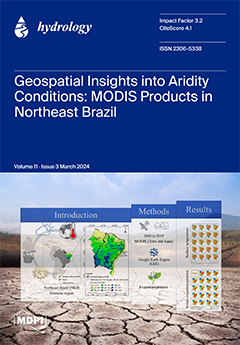Open AccessArticle
Geospatial Insights into Aridity Conditions: MODIS Products and GIS Modeling in Northeast Brazil
by
Jhon Lennon Bezerra da Silva, Marcos Vinícius da Silva, Alexandre Maniçoba da Rosa Ferraz Jardim, Pabrício Marcos Oliveira Lopes, Henrique Fonseca Elias de Oliveira, Josef Augusto Oberdan Souza Silva, Márcio Mesquita, Ailton Alves de Carvalho, Alan Cézar Bezerra, José Francisco de Oliveira-Júnior, Maria Beatriz Ferreira, Iara Tamires Rodrigues Cavalcante, Elania Freire da Silva and Geber Barbosa de Albuquerque Moura
Cited by 4 | Viewed by 3787
Abstract
Northeast Brazil (NEB), particularly its semiarid region, represents an area highly susceptible to the impacts of climate change, including severe droughts, and intense anthropogenic activities. These stresses may be accelerating environmental degradation and desertification of soil in NEB. The main aim of this
[...] Read more.
Northeast Brazil (NEB), particularly its semiarid region, represents an area highly susceptible to the impacts of climate change, including severe droughts, and intense anthropogenic activities. These stresses may be accelerating environmental degradation and desertification of soil in NEB. The main aim of this study was to gain geospatial insights into the biophysical parameters of surface energy balance and actual evapotranspiration on a multi-temporal scale, aiming to detect and analyze the spectral behavioral patterns of areas vulnerable to degradation processes, based on thematic maps at the surface, for NEB and mainly the semiarid region of NEB from 2000 to 2019. Geospatial data from 8-day MODIS sensor products were used, such as surface reflectance (Terra/MOD09A1 and Aqua/MYD09A1), surface temperature (Terra/MOD11A2 and Aqua/MYD11A2), and actual evapotranspiration (Terra/MOD16A2 and Aqua/MYD16A2), version 6. Therefore, in this study, pixel-to-pixel values were processed by calculating the average pixel statistics for each year. From the reflectance product, digital processing of the surface albedo and spectral vegetation indices was also carried out, using computational programming scripts and machine learning algorithms developed via the Google Earth Engine (GEE) platform. The study also presents a seasonal analysis of these components and their relationships over 20 years. Through vegetation indices and statistical correlations, a new predictive model of actual evapotranspiration was developed. The quantitative and spatiotemporal spectral patterns of the parameters were assessed through descriptive statistics, measures of central tendency and dispersion, and statistical error analyses and correlation indices. Thematic maps highlighted the pixel-to-pixel results, with patterns of high temperature distribution mainly in the central and northeastern part of NEB and the semiarid region of NEB, highlighting the formation of persistent heat islands over time. Meanwhile, in these areas, the maps of actual evapotranspiration showed a drastic reduction due to the lesser availability of energy. Over time, the semiarid region of NEB presented areas with little and/or no vegetation cover, which were highly well-defined between the years 2012 and 2019, confirming that these areas are extremely vulnerable to degradation and desertification processes due to significant loss of vegetative and water resilience. The components of energy balance were highly interconnected to climatological and environmental conditions, showing the severe results of drought and accentuation of the water deficit in NEB, presenting a greater condition of aridity in the semiarid region of NEB over time.
Full article
►▼
Show Figures





